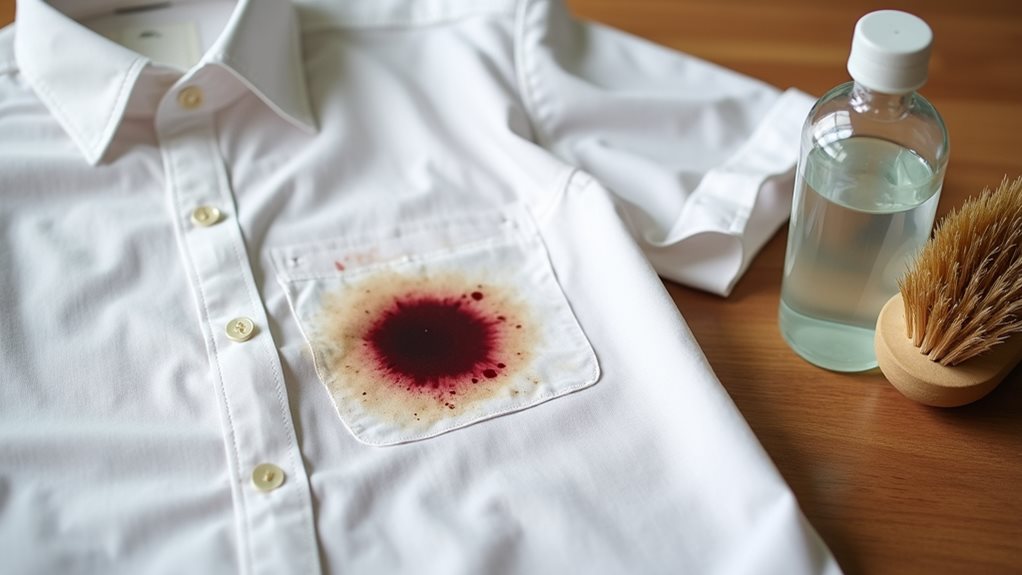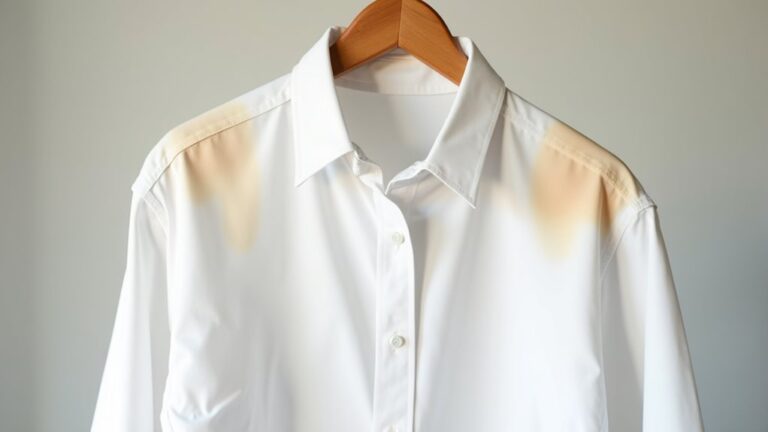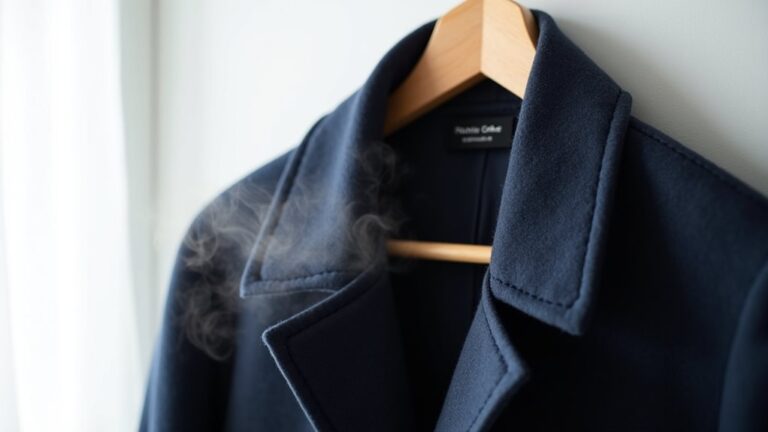Yes, dry cleaning can often remove old stains that seem permanently set, though success depends on the stain’s age, type, and previous treatment attempts. Professional cleaners use specialized enzyme solutions and advanced solvent systems that break down stain bonds at the molecular level, something your home remedies simply can’t match. Oil-based stains respond particularly well, while protein stains like sweat benefit from targeted enzyme treatments that preserve fabric integrity while lifting stubborn marks that have bonded deep within fibers over time.
Understanding How Old Stains Bond With Fabric Fibers
Time becomes the enemy when it comes to stains, and I’ve learned this lesson the hard way after discovering a mystery coffee ring on my favorite blazer that had been sitting in my closet for months.
You see, old stains don’t just sit on fabric fibers—they actually bond with them like unwelcome houseguests who’ve decided to move in permanently.
When you wait too long, removing the stain becomes exponentially harder because it penetrates deeper into the material’s structure.
Heat exposure from your dryer can make matters worse by stain setting, creating a chemical reaction that locks everything in place.
Even a professional dry cleaner with specialized techniques might struggle with permanent discoloration at that point.
While dry cleaning uses chemical solvents that can tackle many stubborn stains that water-based washing cannot handle, the age of the stain significantly impacts the success rate of removal.
Types of Old Stains That Respond Best to Dry Cleaning
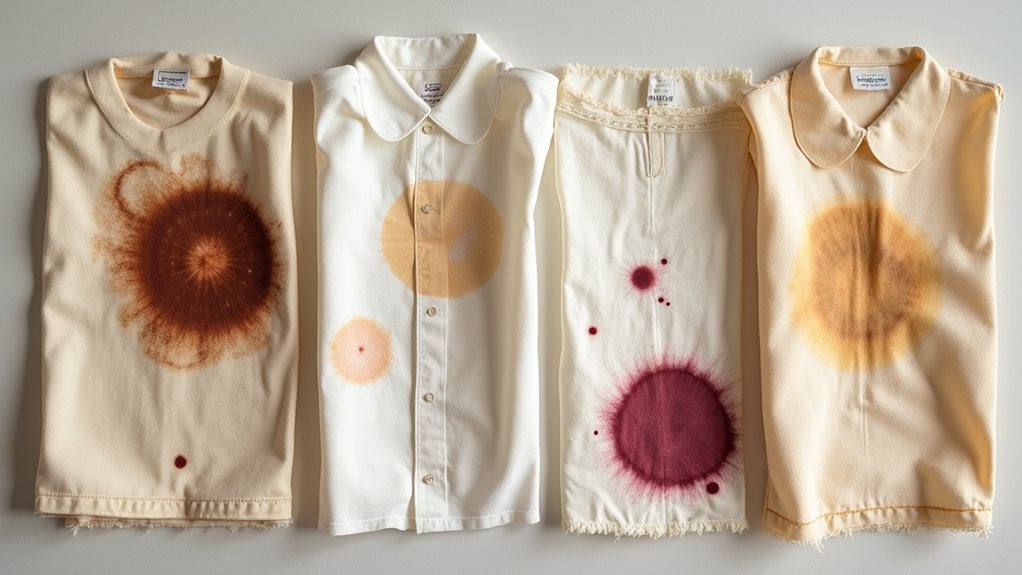
While not all old stains are created equal, I’ve discovered through countless trips to my trusted dry cleaner that certain types practically beg for professional intervention, and knowing which ones can save you both heartbreak and money.
Tannin stains from that red wine mishap at your anniversary dinner respond beautifully to dry cleaning’s specialized solutions, especially when you resist the urge to scrub frantically at home.
That panicked scrubbing you’re tempted to do will only drive the wine deeper into those precious fibers.
Protein-based stains like blood or sweat practically melt away under professional enzyme treatments that protect fabric integrity better than your kitchen sink experiments.
Oil-based stains from cooking adventures are no match for solvent-based cleaning agents designed specifically to dissolve stubborn lipids.
Even challenging dye stains can lighten greatly, though I’ll admit my success rate varies depending on the culprit.
For sweat stains specifically, chemical solvents can break down the proteins and salts in perspiration more effectively than water-based cleaning methods, though success depends on factors like the age of the stain and fabric type.
Professional Techniques Used for Treating Set-In Stains
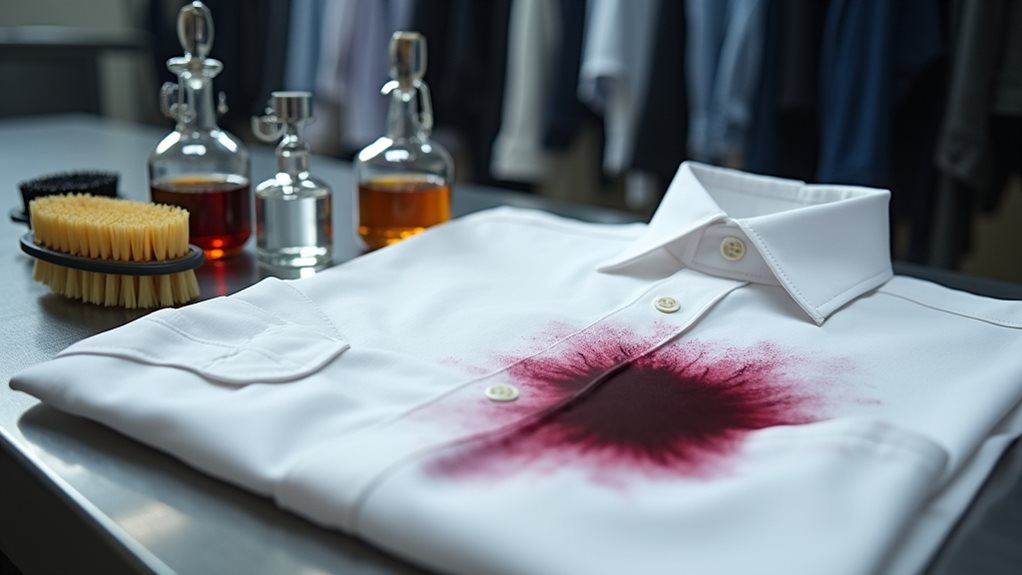
When you bring that favorite shirt with the mysterious stain from last summer’s barbecue to a professional dry cleaner, you’re fundamentally handing it over to a stain detective armed with an impressive arsenal of specialized weapons.
These pros don’t just throw your garment into a standard cleaning cycle and hope for the best – they’ve got advanced solvent systems that can tackle oil-based nightmares, enzyme treatments that literally eat away at protein stains, and carefully controlled heat and pressure techniques that can coax out even the most stubborn set-in marks.
I learned this the hard way after trying every Pinterest hack imaginable on a wine stain, only to watch a professional spotter work actual magic in about ten minutes using methods I’d never even heard of! 😅
Professional dry cleaners use chemical solvents instead of water, which makes them particularly effective at removing oil-based stains, grease, and makeup that regular washing machines simply can’t handle.
Advanced Solvent Systems
Professional dry cleaners wield an impressive arsenal of advanced solvent systems that can tackle those stubborn, set-in stains you’ve probably given up on, and honestly, watching them work feels a bit like witnessing kitchen chemistry magic unfold before your eyes.
These non-water-based solvents penetrate deep into fabric fibers, reaching molecular levels where your home washing machine simply can’t compete. When professional dry cleaning technicians deploy specialized enzyme solutions, they’re literally breaking down proteins and oils that have bonded with your fabric over time.
What’s particularly brilliant about these systems is how they achieve thorough cleaning while preserving delicate fabrics’ integrity – something I learned the hard way after ruining my favorite silk blouse with aggressive home stain removal attempts.
The most common solvent used in this process is perchloroethylene, which excels at dissolving grease and grime without causing damage to sensitive materials like wool and silk.
Trust me, these advanced techniques make all the difference!
Enzyme Treatment Methods
Among those advanced solvent systems, enzyme treatments represent perhaps the most fascinating approach to conquering old stains.
I’ll never forget watching a dry cleaning technician literally dissolve a three-year-old wine stain from my grandmother’s vintage tablecloth using what looked like nothing more than a clear liquid in a small bottle.
Professional cleaners use these specialized enzyme treatments as powerful stain removal methods that work differently than traditional solvent-based cleaning agents, targeting specific molecular bonds in your stained clothing.
- Protein stains get broken down by proteases that attack blood, sweat, and food residues
- Fat-based stains surrender to lipases designed for grease and oil removal
- Tannin stains from wine or coffee yield to specialized enzymes
These treatments excel at removing a wide range of old stains from delicate fabrics without damage.
The effectiveness of enzyme treatments depends heavily on the stain’s origin and whether any previous cleaning attempts have set the stain permanently into the fabric fibers.
Heat and Pressure
After watching countless stubborn stains surrender to enzyme treatments, I discovered that dry cleaners have another powerful weapon in their arsenal: the precise application of heat and pressure, which transforms seemingly impossible cleaning challenges into manageable victories through carefully controlled temperature and force.
Professional spotters combine specialized solvents with targeted heat to loosen those stubborn stains that’ve practically become part of your fabric’s DNA. The pressure they apply helps cleaning agents penetrate deeper, reaching areas where old stains love to hide.
I’ve watched skilled technicians work their magic on protein-based culprits like blood and sweat, carefully monitoring temperature levels to avoid damaging delicate materials. This effective duo can remove what seems permanent, giving your favorite garments a genuine second chance at life.
The success of these heat and pressure techniques ultimately depends on several critical factors, including the specific type of stain, how long it has been set into the fabric, and the fabric involved in the cleaning process.
Factors That Affect Success Rates for Old Stain Removal
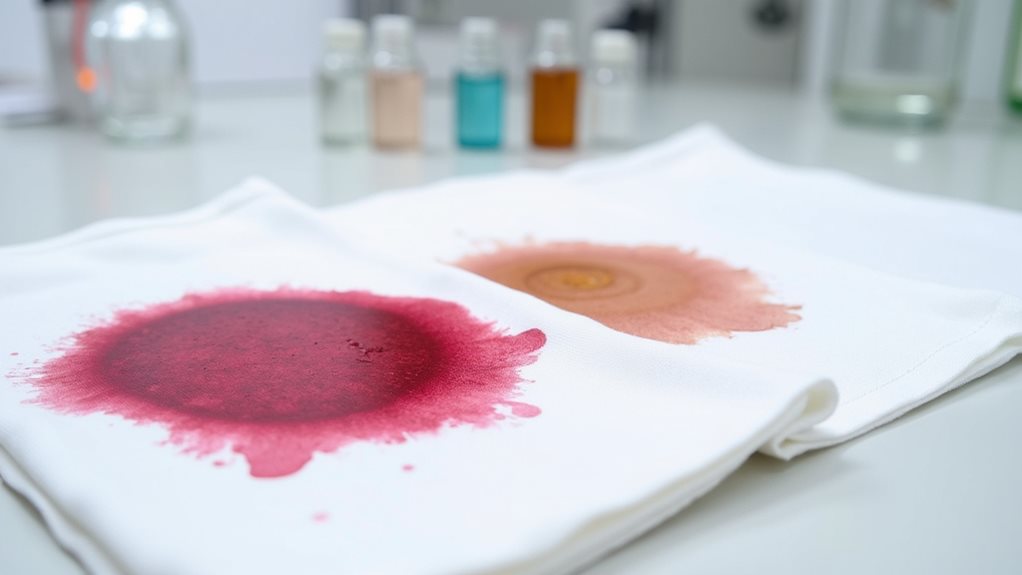
When you’re hoping to rescue that favorite shirt with the mysterious stain from last year’s barbecue, you’ll need to understand that several key factors determine whether your dry cleaner can work magic or deliver disappointing news.
The age of your stain matters greatly, as does the type of fabric you’re dealing with—silk requires a gentler touch than sturdy cotton, while polyester might surprise you with its stubborn resistance to treatment.
Perhaps most importantly, any previous attempts you’ve made at home removal, especially if they involved heat or harsh chemicals, could have actually made your cleaner’s job notably harder than it needed to be.
While dry cleaning excels at breaking down oil-based stains and grease using specialized chemical solvents, water-based stains like sweat or blood may prove more challenging to eliminate completely.
Stain Age and Setting
While I’ve learned this lesson the hard way after ruining more than my fair share of favorite shirts, the harsh reality is that time becomes your enemy the moment a stain touches your clothing.
The stain age dramatically affects your chances of successful removal, as those pesky spots bond deeper into fabric fibers with each passing hour.
Here’s what happens when you delay prompt action:
- The chemical composition actually changes, creating permanent discoloration that even professional dry cleaners struggle with
- Heat exposure from dryers or ironing fundamentally “cooks” the stain into your fabric’s integrity
- Older stains require specialized treatment that’s more expensive and less guaranteed
Setting the stain becomes inevitable without immediate intervention, transforming what could’ve been a simple fix into a costly restoration project that might only lighten, not eliminate, your wardrobe disaster.
Additionally, previous cleaning attempts using water or household remedies can actually make stains worse by setting them deeper, which is why chemical solvents used in dry cleaning are often more effective for tackling these stubborn, aged stains.
Fabric Type Considerations
Since fabric type plays such a crucial role in determining whether your beloved garment will survive the old stain removal process, I’ve discovered through countless wardrobe mishaps that understanding your material’s personality can mean the difference between restoration success and saying goodbye forever.
Delicate fabrics like silk require specialized attention because they’re basically the drama queens of textiles – one wrong move and they’ll tear or discolor faster than you can say “oops.”
Natural fibers absorb stains deeply, making them stubborn opponents, while synthetic materials often laugh in the face of spills.
The success rate drops markedly when protective coatings interfere with the cleaning process, and older fabrics risk damaging during aggressive treatment.
Sometimes stains become permanent simply because the fabric can’t handle the cure.
When dealing with fabrics that require traditional dry cleaning solvents, it’s worth considering that PERC residues can linger on garments, so proper airing out becomes even more important for items you’ll wear close to your skin.
Previous Treatment Attempts
Before you march confidently into that dry cleaner’s shop, I need to share something that might sting a little: your well-intentioned home treatment attempts could’ve actually made things worse. 😅
I learned this the hard way after spending an entire Saturday scrubbing my favorite blazer with every household remedy I could Google, only to discover I’d fundamentally baked the wine stain permanently into the wool fibers.
Here’s what previous treatment attempts can do to complicate the removal process:
- Harsh chemicals trigger chemical reactions that create permanent discoloration
- Heat or scrubbing causes the stain bonds to deepen into fabric fibers
- Wrong products damage texture, making successful removal nearly impossible
Professional dry cleaners need complete details about your stain removal attempts to assess risks and effectiveness of their treatments. This is particularly important for items that should never have been washed at home in the first place, as attempting to clean dry clean only garments with conventional washing methods often results in permanent damage that complicates professional stain removal efforts.
When Home Remedies Fail and Professional Help Is Needed
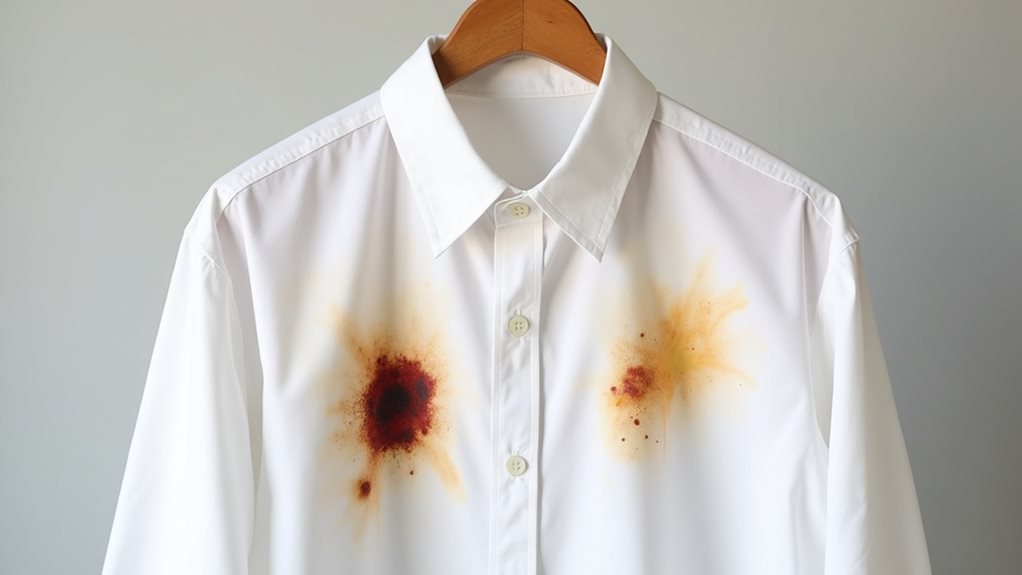
Although we’ve all been there with our sleeves rolled up, armed with baking soda and vinegar like some kind of domestic warrior, there comes a humbling moment when you realize that stubborn wine stain from last year’s holiday party isn’t budging no matter how much elbow grease you apply.
Here’s the reality check: while home remedies work wonders on fresh spills, older stains demand professional treatment because they’ve fundamentally become one with your fabric through chemical reactions and deep penetration.
When you’re facing removal without damaging your beloved garment, expert intervention becomes your best friend. Professional dry cleaning can remove what your DIY attempts couldn’t, using specialized enzyme solutions and the perfect cleaning method customized to your specific stain’s age and nature.
The Science Behind Dry Cleaning Solvents on Aged Stains
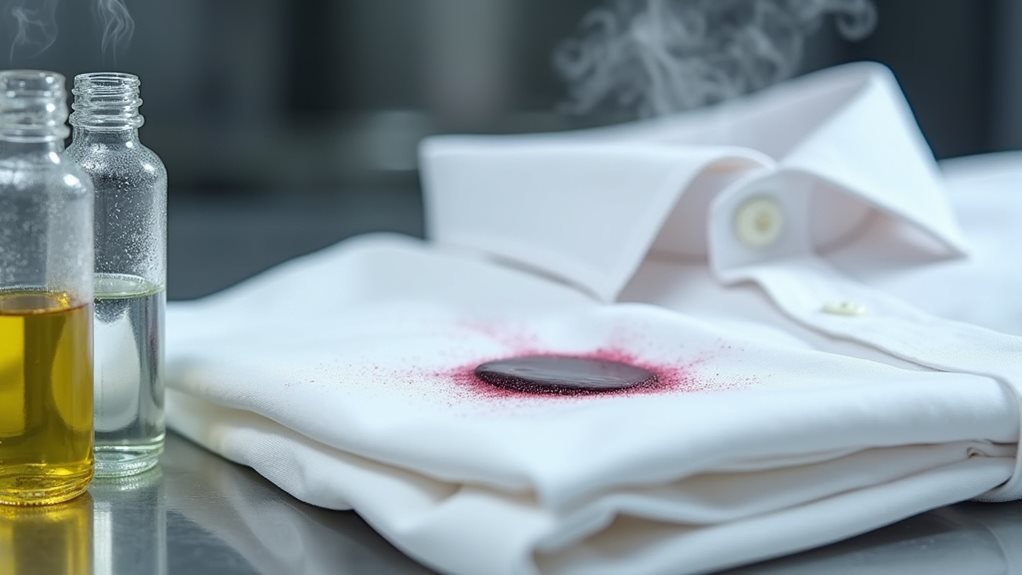
Understanding what happens when professional cleaners get their hands on your seemingly hopeless garment requires a peek behind the curtain at the molecular magic taking place in those industrial machines.
Dry cleaning solvents work like tiny demolition crews, breaking down the chemical composition of aged stains that have bonded with your fabric’s fibers over time.
Here’s what makes solvent-based cleaning agents so effective:
- They dissolve stain bonds at the molecular level, reaching deeper than water-based methods
- Advanced techniques protect delicate fabrics while targeting stubborn marks
- Professional equipment applies precise pressure and temperature for ideal stain removal
Professional dry cleaners understand that preserving integrity matters as much as removing stains.
When you communicate the stain’s age and nature, they’ll select the right solvent combination, transforming your “lost cause” garment back into something you’ll actually want to wear again.
Maximizing Your Chances of Successful Old Stain Removal
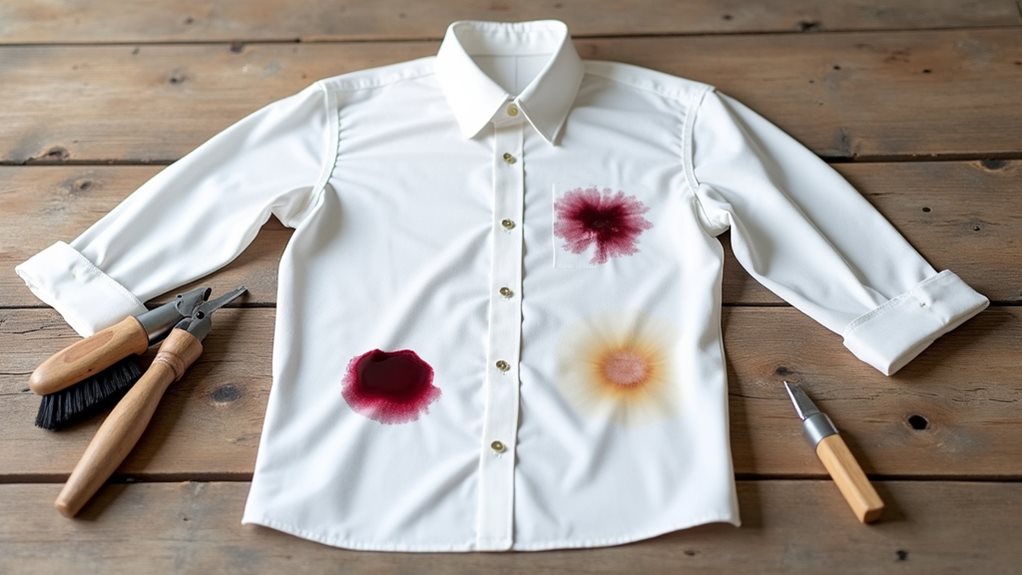
When I discovered my favorite silk blouse buried in the back of my closet with what looked like an ancient coffee stain, I almost tossed it in the donation pile—but then I remembered something my grandmother used to say about second chances.
You can maximize your chances of successful removal by acting quickly, even with old stains. Professional dry cleaners need complete honesty about the stain’s history, what you’ve tried before, and how long it’s been there.
Their specialized solvents used for delicate fabrics work better when they understand the full story. Quality dry cleaning services employ targeted removal techniques that home stain treatment simply can’t match.

